5-4 Let’s Play – Supporting Language and Literacy
A – Playing to Support Language and Literacy
So far we have talked a lot about how back-and-forth conversations support children’s language development.
Language development doesn’t happen only during center time, circle time, or meal time. Play time also provides children with a rich environment for language growth.
Many types of play support language development. For example, during symbolic play, or make-believe play and storytelling, children develop representational skills.
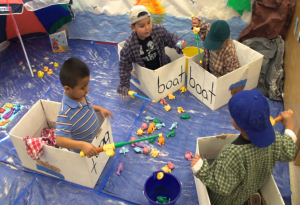
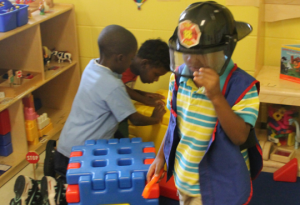
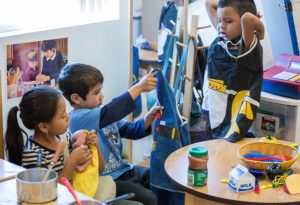
Each time children pretend to be captains of a ship, they must draw on their own mental representation of a ship captain: what they do, what they look like, and what instruments they might use.
In many ways, symbolic pretend play and literacy share similar mental processes. Both require children to use stand-ins for known items. For example, using a banana as a phone to call dad is much like realizing that the sound of the word phone and the letters p-h-o-n-e are meant to represent the idea of a phone as well.
Through play, children also learn new words from parents, peers, and educators and begin to develop their oral language skills, moving from simple, two-word statements to telling whole stories.
Eventually, children use playtime to develop their overall narrative skills. Children learn to tell more and more complex, imaginative stories—both in cooperation with others and on their own.
Dramatic free play offers many opportunities to build language skills, like figuring out how to ask for things, describing things, and directing play.
Providing culturally significant props, rhymes, and games for children to explore during play encourages adults and children to engage in meaningful and culturally inclusive interactions.
Building Vocabulary
Guided play, where children direct the play but an adult joins in, can also be a powerful learning tool.
When play is child-driven, whether children are playing on their own or with the support of an adult, they are engaged. This is because children are able to play in the way that they are most interested in at the time. As mentioned in the previous slide, play often is make-believe or fantastical.
Researchers wanted to know if following a story session with an adult-supported play session would help children learn new vocabulary words. In the study, groups of children listened to stories from one of two learning themes: A realistic theme—farming and cooking—or a fantastical theme, such as dragons and castles.
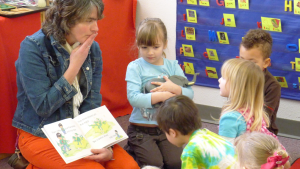
Each book contained 10 new words that the educator that day was focusing on. To teach the target words, educators defined the word, used the word in a sentence, and, when possible, demonstrated what the word meant using gestures.
Here is an example from the study. One of the target words in the fantastical theme was emerge. The text in the book read: “A little dragon with smoke coming from his nose emerged from the egg.” Immediately after this sentence, the educator defined the word for the children: “The little dragon came out of the egg; he emerged from it. See how Grog is emerging from the egg?””
Once the educator finished the story, they went over all of the words, using the pictures in the book and making hand gestures when possible. For example, an educator might say, ”’And who is this (pointing to picture in book)? Yes, that is Grog, the little dragon who just emerged from the egg. Can you use your hands and help me act out what he did?” The educator might cover one hand with the other then poke one finger through. “He emerged from the egg.”
Next we’ll talk about the adult-supported play that followed the book-reading.
Vocabulary and Play with Adults
After the reading session, children had 10 minutes to play with a set of replica toys featured in the book, either on their own or in a supported play session with an adult.
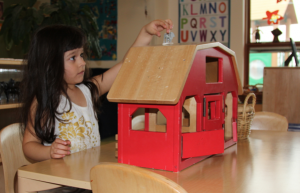
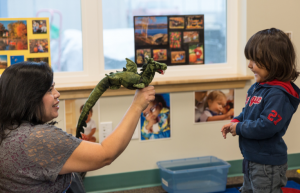
In the supported play sessions, adults encouraged children to act out sections of the book or asked open-ended questions about their play. While they were playing, the educator used each new word three times and defined each word once.
The researchers in the study found that children learned more of the new words when they played in the adult-supported play session than when they played on their own.
In the next part of the study, the researchers wanted to know if the children learned more from the realistic theme or the fantastical one. They found that the children who listened to a story and played with the fantastical themed toys showed more improvement in their productive knowledge of the new words, or their ability to describe what the word meant than those who heard a realistically themed story and played with realistically themed toys.
For example, to measure this, the adult might ask, “What are weeds?” or “Do you know what the word weeds means?”
While we don’t know for sure why the children in this study learned more from the fantastical themed reading and play session, the researchers think it might be because children have to do more cognitive processing when they are learning words in a fantastical context. They have to imagine a world that they have never experienced, and think about what the world might be like.
It is possible that when they learn new words in this context, they are thinking and engaging with the words more deeply. This suggests that using guided play and adding fantastical themes to classrooms can be helpful as children learn new words.
B- Storytelling
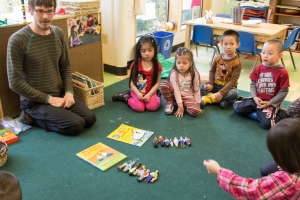
Another way to support children’s language and literacy learning in a playful way is through storytelling.
A recent study examined whether including storytelling and story-acting practice as a regular component of preschool curriculum could help build key school readiness skills like creativity, communicating and speaking, emergent literacy, and emotional functioning.
While pretend play and storytelling are different, they both have narrative elements. Active, child-driven storytelling and story-acting can be an opportunity for playful learning.
In this study, children in Head Start preschool programs were given the opportunity to dictate a story to an educator during free choice time. The choice to tell a story was completely voluntary and child-driven.
As the child told the story, the educator wrote it down exactly as the child said, occasionally asking questions like: “What happened next?” or “Is that the end?”
Later in the day, the educator read the story aloud, while the child author acted it out with other children of their choosing. Story sessions happened about twice a week for the duration of the school year.
At the end of the year, researchers found differences in the children who were in storytelling and acting environments compared to those who were in environments that did not participate in storytelling or acting.
Children in the storytelling classrooms had improved oral language skills, including narrative comprehension, emergent literacy skills (including print and word awareness), social competence (including greater self-inhibition and reduced play disruption), and pretend abilities.
Through participating in regular opportunities to create, narrate, and act out stories, children gained school readiness skills across domains.
Creating Play Environments
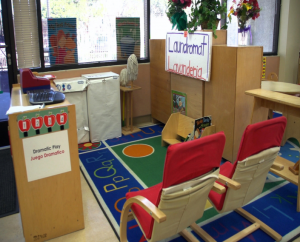
Providing supported storytelling and story-acting opportunities in your program can be a way to build language and literacy skills.
You can also encourage language and literacy development through open-ended questions about play activities. Asking children to describe and explain what they are doing helps them build their language and literacy skills.
Supporting play environments for language and literacy can also include setting up dramatic play areas with props, such as elements found in fairy tales or other favorite books, to promote telling and retelling of stories.
Placing labels on objects in dramatic play areas also helps build vocabulary and reading skills. By adding labels to novel items, you can draw attention to new vocabulary. You can also encourage the use of that vocabulary by including those pieces in familiar play activities.
Labeling items in multiple languages is also one way to support children who are dual language learners—and dual language learning among all children in your program.

Reflection Point
Consider these questions:
- Play can be a powerful learning tool. Why do you think that might be true?
- How could you include playful learning strategies in your work supporting children’s language and literacy development?
 References
References
Nicolopoulou, A., Cortina, K. S., llgaz, H., Cates, C. B., & de Sá, A. B. (2015). Using a narrative- and play-based activity to promote low-income preschoolers’ oral language, emergent literacy, and social competence. Early Childhood Research Quarterly, 31, 147–162. [Online Article]
Sachs, J. (1987). Preschool boys’ and girls’ language use in pretend play. In S.U. Philips, S. Steele, & C. Tanz (Eds.), Language, gender, and sex in comparative perspective (pp. 178–188). Cambridge University Press.
Weisberg, D. S., Ilgaz, H., Hirsh-Pasek, K., Golinkoff, R., Nicolopoulou, A., & Dickinson, D. K. (2015). Shovels and swords: How realistic and fantastical themes affect children’s word learning. Cognitive Development, 35, 1–14.
EarlyEdU Alliance (Publisher). (2018). 5-4 Let’s play – Supporting language and literacy. In Child Development: Brain Building Course Book. University of Washington. [UW Pressbooks]

